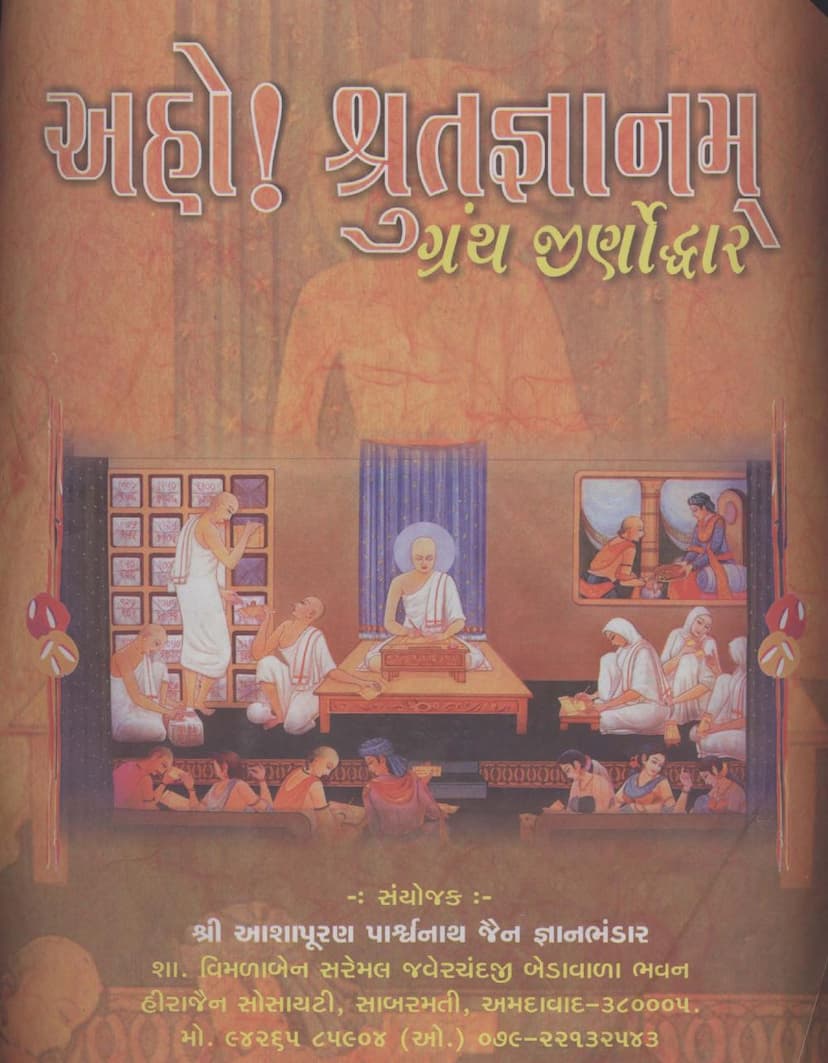Sanmatitarka Prakaranam Part 1
Added to library: September 2, 2025

Summary
Sanmatitarka Prakaranam Part 1: A Comprehensive Summary
This document is the first part of the "Sanmatitarka Prakaranam," a significant Jain text, published by Gujarat Puratattva Mandir, Ahmedabad. The work is a product of the "Aho Shrut Gyanam Granth Jirnoddhar" (Preservation of Valuable Scriptures) initiative, aiming to revive and disseminate ancient Jain knowledge. The book is compiled and presented by Sukhlal Sanghavi and Bechardas Doshi.
The initial pages (1-11) of the provided text do not contain the actual content of "Sanmatitarka Prakaranam Part 1" itself. Instead, they list numerous other books that were part of the "Aho Shrut Gyanam Granth Jirnoddhar" project, spanning various subjects including scriptures, commentaries, philosophy, grammar, logic, architecture, and history, predominantly in Sanskrit and Prakrit, with some in Hindi and Gujarati. This extensive list serves as an index of the preserved literary heritage.
However, pages 12-27 provide a detailed editorial preface in Gujarati that sheds light on the importance and context of the "Sanmatitarka Prakaranam." Here's a summary of the key points from the preface:
1. Introduction to Sanmati (Sammatitarka Prakarana):
- Author: Acharya Siddhasena Divakara, a highly respected Jain philosopher and scholar of Sanskrit and Prakrit. He is believed to have lived in the 1st century Vikram era, though some historians place him in the 5th century Vikram era. His works are foundational to Jain logic and philosophy.
- Original Language: The core text of "Sammatitarka Prakaranam" is in Prakrit.
- Key Philosophical Concepts: The book delves into core Jain concepts like Naya (standpoints), Saptabhangi (sevenfold predications), knowledge, perception, substance, and modes, analyzing them through a logical lens. It emphasizes the principle of Anekanta (non-absolutism) in Jainism.
- Target Audience: The original text aims to establish the principles of Anekanta, primarily for ancient Jain scholars, adhering to the tradition of Jain Agamas.
2. The Commentary (Tattva-bodha-vidhayini):
- Author: Acharya Abhayadeva Suri, a disciple of Pradyumna Suri of the Shvetambara Rajagachchha. He is believed to have lived in the 10th century Vikram era.
- Original Language: The commentary is in Sanskrit.
- Nature of Commentary: Abhayadeva Suri's commentary is described as exceptionally profound and extensive. It meticulously dissects philosophical arguments and meticulously records the diverse viewpoints and counter-arguments prevalent in Indian philosophy up to the 10th century Vikram era. The preface highlights that the commentary systematically presents opposing views, starting with the most divergent, then gradually refining them towards the anekantavadi (Jain) conclusion. This structure is likened to a philosophical council where each viewpoint is independently presented and debated.
- Significance: The commentary is considered a valuable repository of philosophical debates and a crucial resource for understanding the history of Indian philosophical thought. It is noted that later works like Syadvada Ratnakara by Vadideva Suri and Nyayakumudachandrodaya by Prabhachandra Suri reflect the influence of Abhayadeva's commentary on Sammatitarka.
3. Publication Details and Plan:
- Preservation Effort: The publication is part of the "Aho Shrut Gyanam Granth Jirnoddhar" project, indicating a conscious effort to save and circulate rare and valuable ancient Jain texts.
- Manuscript Sources: The project utilized approximately 25 handwritten manuscripts from various parts of India to ensure accuracy and completeness, with 17 being actively used for this edition.
- Publication Structure: The plan was to publish the annotated original text in three volumes, with a fourth volume dedicated to the translation of the original text and useful appendices, introductions, and indices. The current publication represents the first volume.
- Collaboration and Support: The preface acknowledges the financial and scholarly contributions from various institutions and individuals, including Shri Ashapooran Parshwanath Jain Gyan Bhandar, Shah Baboolal Sarmal Bedawala, and Shah Vimalaben Saremal Javerchandji Bedawala. The inspiration for the publication came from Ganivaraya Shri Nayabhidvijayji Maharaj.
4. Textual Specificity:
- Distinguishing Features: The preface emphasizes the unique value of "Sammatitarka" due to its author, Siddhasena Divakara, and its comprehensive external and internal structure.
- External Structure: The book consists of the original Prakrit text ("Sammatitarka") and the Sanskrit commentary ("Tattva-bodha-vidhayini"). The original text is composed of Aryas (a type of meter) and is divided into three Kandas (sections), comprising 167 Gathas (verses). The commentary is in prose and extends to approximately 25,000 shlokas (verses or poetic lines).
- Internal Structure: The work is primarily philosophical, focusing on the principle of Anekanta. It rigorously dissects philosophical concepts, discussing their validity and utility. The author's approach is described as logical and deeply rooted in Jain Agamic traditions, while the commentary focuses on refuting other philosophical schools.
In essence, the preface highlights "Sanmatitarka Prakaranam" as a monumental work of Jain philosophy and logic, preserved and presented with meticulous scholarly effort. It underscores the depth of Jain thought through its exploration of core principles and its engagement with the broader philosophical landscape of ancient India. The preface serves as an invitation to scholars and seekers of knowledge to delve into this invaluable scripture.